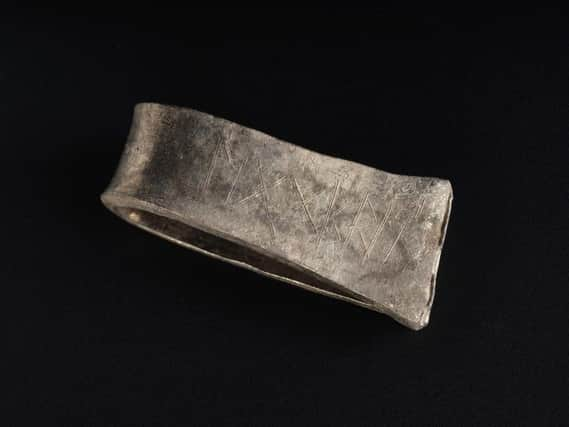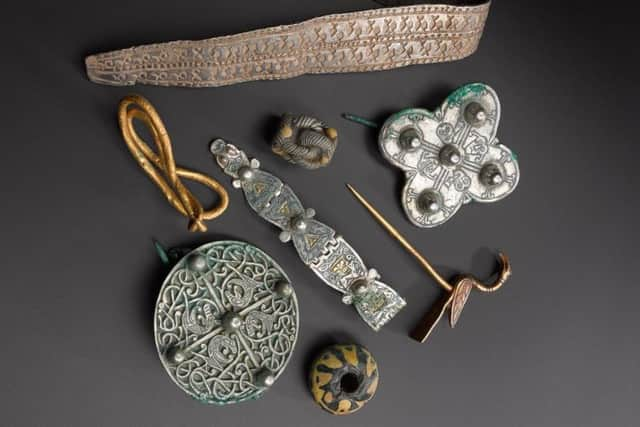Man who wore silver arm ring from Galloway Hoard treasures revealed


An examination of Anglo-Saxon runic inscriptions on the pieces have revealed the name “Ecgbeorht” or, in its more modern form, Egbert.
Dr Adrian Maldonado, Glenmorangie Research Fellow at National Museums Scotland, said it was "really exciting" to make the connection between a person and the treasure, which was buried in Galloway around 1,100 years ago.


Advertisement
Hide AdAdvertisement
Hide AdDr Maldonado said the Anglo-Saxon inscriptions raised more questions about the hoard and "transforms thinking" about the Viking Age in Scotland and possible connections with Anglo-Saxons in this part of the country.
He added: "These inscriptions are evidence that identity was complex in the past, just as it can be today.
"In Early Medieval Scotland, we have inscriptions in five different scripts - Latin, ogham, Pictish symbols, Scandinavian and Anglian runes - making it a diverse and multilingual era.
"Place-names in British, Gaelic, Norse and Old English were being coined in South West Scotland around the time of the Galloway Hoard.
"The sea was more like a motorway, allowing people to communicate across linguistic boundaries, exchanging ideas and objects. This is just a glimpse of how the Galloway Hoard will continue to challenge our thinking as conservation continues.”
The runes were read by Dr David Parsons of the University of Wales.
He said: “Five of the silver arm-rings have runic inscriptions scratched into them which may have functioned as labels identifying distinct portions of the hoard, perhaps recording the names of the people who owned and buried them.
"Arm-rings of this sort are most commonly associated with Viking discoveries around the Irish Sea coastlands. Yet these runes are not of the familiar Scandinavian variety common around this date on the nearby Isle of Man, but of a distinctively Anglo-Saxon type.
Advertisement
Hide AdAdvertisement
Hide Ad"And while several of the texts are abbreviated and uncertain, one is splendidly clear: it reads Ecgbeorht, Egbert, a common and thoroughly Anglo-Saxon man’s name."
Dr Parson said there was reason to suspect that the Galloway 'Viking' Hoard may have been buried by people who considered themselves part of the English-speaking world.
He said: "It is even possible that these were locals: "Galloway had been part of Anglo-Saxon Northumbria since the early eighth century, and was referred to as the ‘Saxon coast’ in the Irish chronicles as late as the tenth century.”
Dr Parsons will be discussing the findings along with other surviving early medieval inscriptions from south-west Scotland in ‘The Riddle of the Runes’, the 17th annual Whithorn Lecture at the Wigtown Book Festival on Saturday 5 October.
As well as the arm-ring with the full name of Egbert, four others have runic inscriptions. Three appear to be abbreviated Germanic names, probably also Old English, whilst the fifth has still to be deciphered, but all are in Anglo-Saxon runes
The Galloway Hoard brings together the richest collection of rare and unique Viking-age objects ever found in Britain or Ireland.
"It is of international significance and will transform our understanding of this period of Scottish history. Buried at the beginning of the tenth century, it comprises in excess of 100 gold, silver and other items, some of which are unique.
The Hoard was discovered in 2014 on Church of Scotland land by metal detectorist Derek McLennan.
Advertisement
Hide AdAdvertisement
Hide AdIt was found on farm land near Loch Ken at Balmaghie, to the north west of Castle Douglas, Kirkcudbrightshire.
He is now being sued by the Kirk, which is hoping to retrieve its share of the £2m paid by National Museum of Scotland for the hoard.
An exhibition of the Galloway Hoard will be displayed at the National Museum of Scotland in May, and will tour thereafter to Kirkcudbright Galleries, The McManus: Dundee’s Art Gallery and Museum and Aberdeen Art Gallery thanks to funding from the Scottish Government.
Following the tour part of the Galloway Hoard will be on long-term display at the National Museum of Scotland in Edinburgh with a significant and representative portion of the Hoard also displayed long-term at Kirkcudbright Galleries.
Hamish Torrie, Corporate Social Responsibility Director at The Glenmorangie Company, said: "This latest reveal from the Galloway Hoard adds yet another layer of understanding as to the make-up of the early people of Scotland and we are delighted that this research can benefit from our support."
